lunar lander
Latest
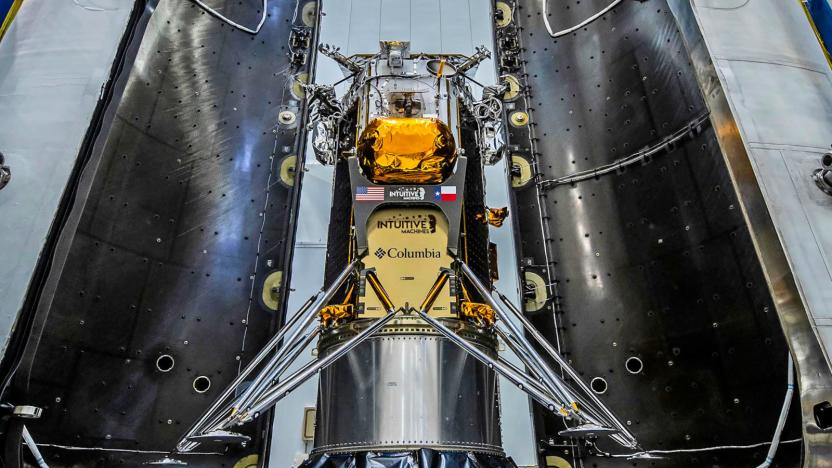
Intuitive Machines' lunar lander begins its multi-day journey to the moon
Intuitive Machines' Odysseus has started making its way to the moon and could make history as the first privately built lander to touch down on the lunar surface.
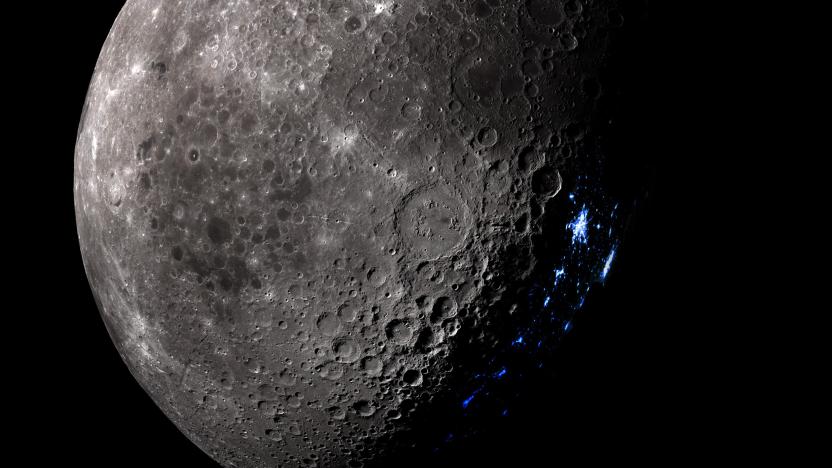
Blue Origin makes another bid for a NASA lunar lander contract
Astrobotic, which has developed a lunar rover, and Boeing are among Blue Origin's latest lunar lander partners.
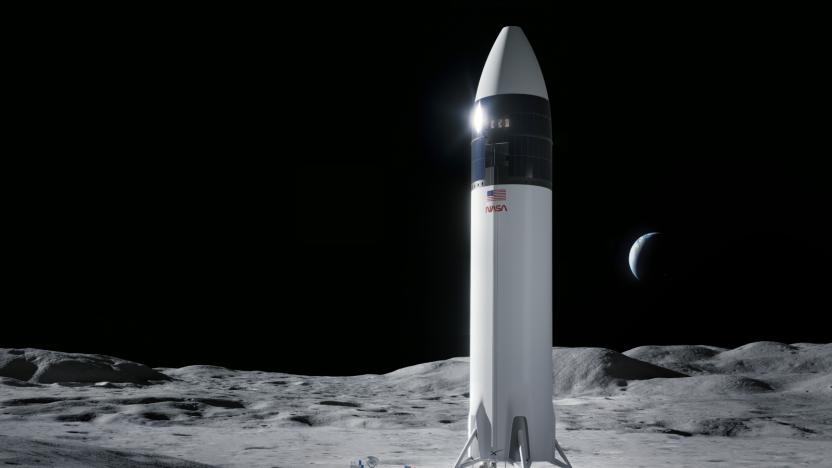
NASA picks SpaceX’s Starship for its second crewed Artemis lunar landing
NASA has expanded SpaceX's role in the Artemis program and has selected the company's Starship lunar lander to ferry the second batch of astronauts to the Moon.
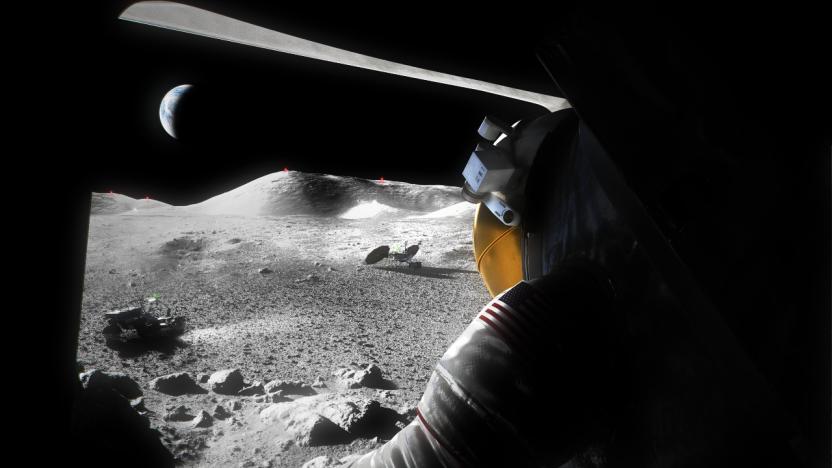
NASA to accept new Artemis lunar lander proposals from commercial companies
The lander will have to be capable of transporting astronauts from lunar orbit to the lunar surface.
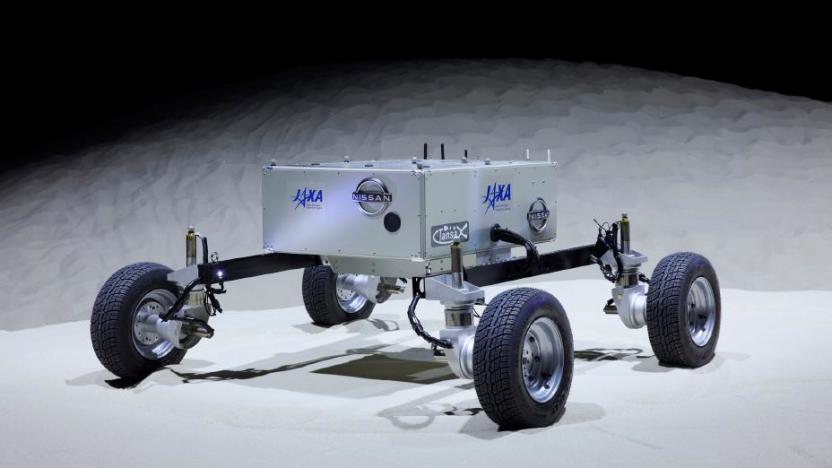
Nissan uses AWD tech to keep JAXA's lunar lander from getting stuck
The automaker employed a version of its e-4orce powertrain system.
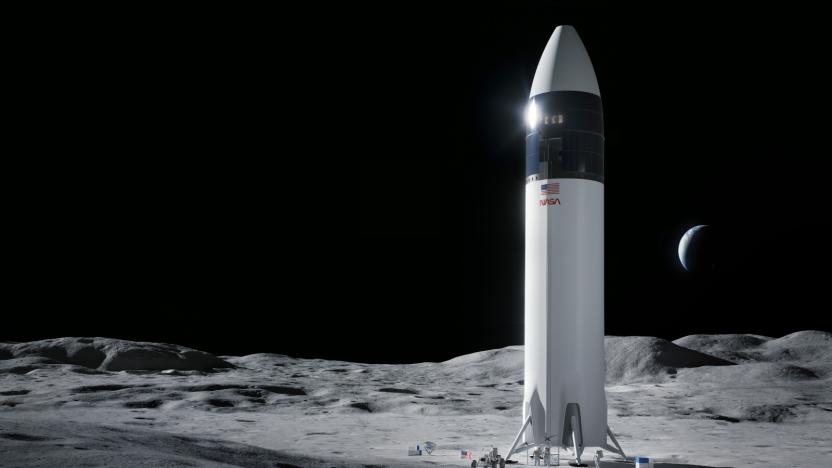
NASA puts SpaceX's lunar lander contract on hold following Blue Origin's lawsuit
NASA agreed to put SpaceX's lunar lander contract on hold due to Blue Origin's lawsuit.
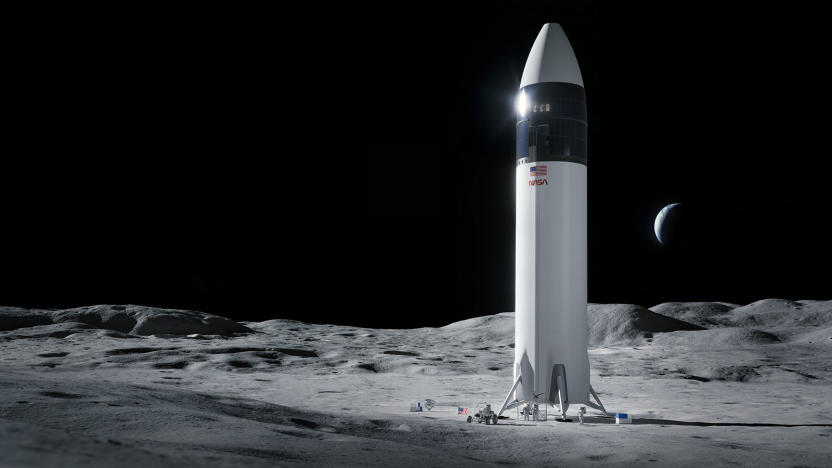
SpaceX wins NASA's Artemis lunar lander contract
Elon Musk's company will take astronauts to the Moon for the first time since 1972.
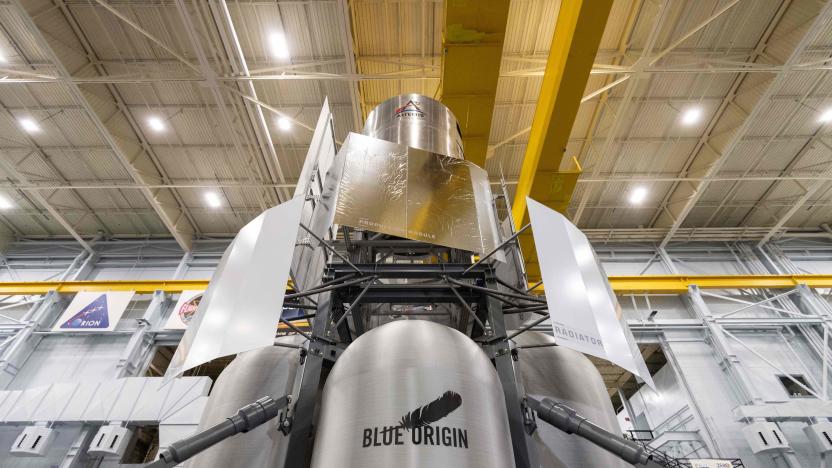
Blue Origin's lunar lander mockup is ready for NASA simulations
Blue Origin and its “National Team” partners Lockheed Martin, Northrop Grumman and Draper have delivered their full scale lunar lander mock-up to NASA. The space agency will use the engineering prototype to simulate how it could get “crew, equipment, supplies and samples off and on the vehicle” in future moon missions.
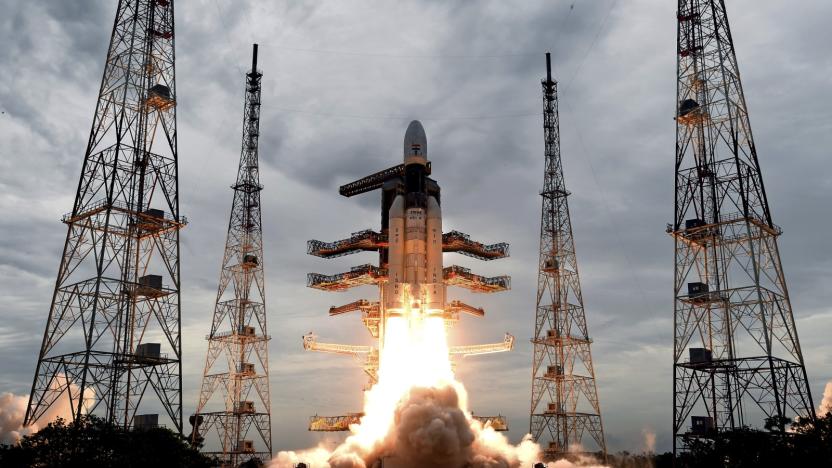
India’s lunar lander crashed within 500 meters of its target
In September, the Indian Space Research Organization (ISRO) lost contact with its Vikram lander as it was making its descent to the lunar surface. If you were one of the people who guessed that Vikram crashed, you are correct. In a report to lawmakers, ISRO has confirmed that Vikram did indeed "hard land."

Blue Origin teams with spaceflight veterans to complete its lunar lander
Blue Origin won't be alone in working on a crewed lunar lander that will (hopefully) participate in NASA's Artemis program. Jeff Bezos' outfit has unveiled a trio of partners that will help it complete the Human Landing System, all of which are space industry veterans. Lockheed Martin will work on the reusable Ascent Element vehicle as well as lead crewed flight ops. Northrop Grumman, meanwhile, will produce the Transfer Element that brings the landing system toward the Moon. Draper, in turn, will handle descent guidance and avionics.

India found its missing Vikram lunar lander
India has located its Vikram lunar lander after losing contact, and the situation isn't looking great. Indian Space and Research Organization chairman K. Sivan said that cameras aboard the orbiter found the spacecraft and believed it had been a "hard landing." There were efforts in progress to contact the lander, Sivan said, although there hadn't been any sign of success as of this writing.

India's Vikram lunar lander lost contact during its descent
Today India attempted to become only the fourth nation to successfully soft-land on the surface of the Moon. That mission appears to have failed, when the Indian Space Research Organisation (ISRO) lost contact with its Vikram lander at an altitude of 2.1km above the lunar surface. The space agency has said only that it is analyzing available data, and that the Chandrayaan-2 spacecraft is still in orbit. Indian prime minister Narendra Modi is scheduled to address the nation at about 10:30 ET. If the mission is lost, then out of three soft-landing attempts this year it will be the second to go awry. China's Chang'e 4 reached the far side of the Moon in January, while the privately-owned Beresheet lander from Israel crashed in April after sending back one last photograph.

China’s rover finds mysterious minerals on the far side of the moon
Early this year, China's Chang'e-4 lunar lander made history when it became the first spacecraft to touch down on the far side of the moon. Now, according to a study published in Nature, the lander's rover, Yutu-2, may have detected the first signs of lunar mantle material. If the minerals it found prove to be part of the moon's mantle, the discovery could help scientists better understand how both the moon and the Earth formed.
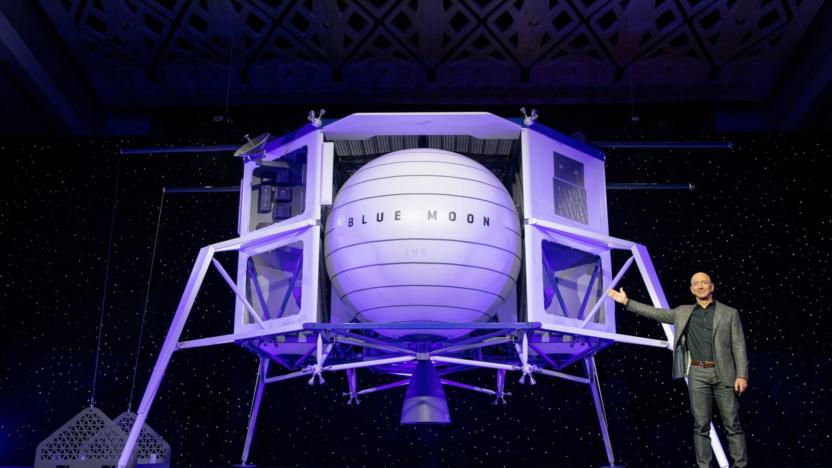
Jeff Bezos reveals his 'Blue Moon' lunar lander
Blue Origin is building a lunar lander aptly called the Blue Moon. Jeff Bezos has announced his space company's shared goal with NASA to go back to our planet's fateful companion in the next few years at an event for media and space industry executives. There, the tech exec has also revealed that Blue Origin is developing a new engine called BE-7 with a 10,000 lbf thrust, strong enough to power the rocket that's ferrying the lander and its large payloads to space. Its first test fire could happen as soon as this summer.

Tesla adds '2048' and Atari’s 'Super Breakout' to its dashboards
Tesla is adding more free games to the dashboard display on Model S, Model X and Model 3 cars. Super Breakout and 2048 are joining other Atari classics Missile Command, Asteroids, Lunar Lander and Centipede, which Tesla added in August. To date, hundreds of thousands of people have played those games, according to the automaker.

Trump asks for $9.6 billion to bolster cybersecurity in 2020 budget
President Donald Trump has revealed his proposed budget for the 2020 fiscal year, which "supports the creation" of Space Force (USSF) as the sixth branch of the armed forces. The White House also hopes to bolster cybersecurity and NASA exploration missions.

Origin Stories: Steve Sande
I certainly didn't start my career with plans to become a blogger and editor at one of the world's most active Apple websites. When I was a child dreaming about a future career path, computer science barely registered on the "What I want to do when I grow up" list since only corporations owned room-sized mainframes at that time and there was no such thing as a home computer. The first time I had any physical contact with a computer was in 8th grade in Aurora, Colorado in the Apollo moon landing year of 1969. The Aurora Public Schools had purchased a Data General Nova (see console photo of a similar model at top of this post) in that year for accounting and scheduling purposes, and some brilliant person came up with the idea of buying some Teletypes that could be used as dialup terminals to allow personnel at the schools to access the main computer remotely. Well, the administrators and teachers at the school weren't all that interested in computers, so guess who started using the Teletypes and Nova to learn how to program in BASIC? The students. Since they wouldn't let us save our programs to paper tape (that would come in about two or three years), any programs we ran were usually quite short out of necessity – we'd type 'em in, run them, try to figure out what the TOO MANY NESTED GOSUBS error meant, and then start all over again. It was fun, but frustrating with no real way to store the programs permanently. In 9th and 10th grade, I was only able to play rarely with the Nova or whatever computer they may have purchased as an upgrade. But when the school announced in 11th grade that the regular algebra class would also be offered in a "computer algebra" version providing access to the school system's minicomputer, I jumped on the opportunity to have a full semester of working with ... the future! Things were a little better at that point. We could save our programs out on paper tape, kind of the "floppy disk" of the era. I think part of the reason we wanted to save to paper tape was that the tape punch created some very good confetti for high school football games... About this time I became very interested in two things; transportation engineering and writing. I had a wonderful high school English teacher by the name of David Faull (still alive and kicking) who really taught me how to write, something I'd need to do in college in those pesky elective courses. I had decided to go into Civil Engineering, and was accepted at the University of Colorado at Boulder. Every engineering student at the time had to take an introductory computer class – CS 101 – in which they were introduced to two things: punch card input and FORTRAN IV. There was nothing worse than sitting down at a keypunch machine with a handwritten FORTRAN coding form, typing in several hundred cards, all of which needed to be read by a machine in order and without typos for your program to run. I can recall hearing of several computer science grad students who had nearly committed suicide after having ultra-long programs scattered to the wind when they accidentally dropped boxes of punch cards... One of my best high school buddies, Rick Brownson, was a student at CU at the same time in the Electrical Engineering department, and I recall that in 1976 he introduced me to an amazing game –- Lunar Lander –- that displayed vector graphics in real time onto a round green-screen terminal. We wasted many a weekend hour playing that game in one of the EE computer labs. Rick also introduced me to the nascent world of personal computing around that time, as he and I soldered chips into a MITS Altair 8800 kit in late 1975. I really wasn't all that impressed with the Altair, since when we finished it there was no way for us to connect it to a display (usually an old TV), and we had no keyboard for it. So we flipped switches on the front of the device to enter 8080 opcodes and then looked at the LEDs to see the results. I remember taking a weekend drive to Albuquerque, New Mexico in 1976 to go to a Altair convention of some sorts; the highlight was getting a pirated copy of Bill Gates' Altair BASIC on paper tape from another attendee. At the time I graduated from engineering school in 1978, word was getting out about Apple, but at the time I really didn't see any reason to buy a computer. Even while I was working in my first job and going to grad school, I refused to buy a computer. When I was able to get a Commodore VIC-20 for about $300 I bought one, then when Commodore reduced the price on the C-64 to about $250 the next week, I returned the VIC-20, got a refund, and picked up a Commodore 64. After a short amount of time I found myself hooked. I bought an Epson printer, got the cassette tape drive, and bought the height of communications technology at the time – a 300 baud modem. I quickly found myself on some of the early bulletin board systems of the time. But the Commodore 64 wasn't a "real computer", so when IBM compatible devices started hitting the market I went out and bought a Sanyo MBC-555 PC clone complete with two floppy drives (a Sanyo MBC-550 with only one floppy is shown below)! This is where I got my first introduction to business software, with WordStar as a word processor and CalcStar as a spreadsheet. At this time, I was working for a natural gas pipeline company called WestGas. The company was a subsidiary of a larger electric and gas utility (Public Service Company of Colorado, now part of Xcel Energy), and as a subsidiary we had of control over our destiny. In the fall of 1983, the Vice President of our company came to me to see if I would perform a study of possible uses for personal computers in our company and create a five-year plan to budget the introduction of those devices, so I jumped to the task. Everything was based on costs and benefits, and a calculated rate of return on the investment in IT. In retrospect, a lot of my numbers were probably quite suspect, as they were based on estimates of time savings that most likely never occurred... The final study saw a need for no more than about 15 PCs over the next five years as well as a handful of dedicated IBM DisplayWriter word processors. About the time that my study was completed, there was a lot of speculation in the computer world about Apple's forthcoming Macintosh. I was interested in seeing one, so a few days after they were introduced my boss and I went over to a Nynex Business Center store to take a look. While the mouse, the bitmapped display, and the 3.5" floppy drive were all amazing, the lack of memory (128K) was a real turnoff. Still, I felt as if I had seen the future, and I vowed to get myself a Mac if they ever built a model with more RAM. Towards the end of the year Apple introduced the 512K "Fat Mac", and the company was doing a "Test Drive A Mac" promotion where you filled out loan paperwork, took a Mac home to use for about three days, and if you decided you wanted to keep it they processed the loan. Having the Mac at home really made me fall in love with it, so in December of 1984 I bought my first Mac. Being enthralled with the Mac, I started lugging it with me to work. By this point I was the supervisor of a group called "Special Projects", and my team was charged with a number of things: regulatory compliance, studies, project management, and now IT. Pretty quickly, my co-workers got began to turn into Mac fans, and I started tweaking the five year plan to buy fewer PCs and more Macs. I was also going to a lot of Mac User Group meetings in those days; that was the place to really try out software, as most everyone would bring boxes of floppies as well as the original disks for new applications they had purchased. Copying was rampant, but I don't remember anyone doing outright pirating; if you tried a program and liked it, you'd end up buying it. That was the case for me in 1985 when I tried out a copy of Aldus Pagemaker (the first "professional" page layout application) and then bought the application. At one point, I bragged to our financial manager that I could use the app to lay out our subsidiary's annual report at a much lower cost than sending it out to a traditional printshop; he called my bluff and for the next month I worked with the very buggy 1.0 software to create the report. In the end, I was successful and the finance department decided to get Macs for everyone. In a few more years, the engineering role ended for me and I was a full-time IT manager. Starting in 1987 and through 1994, I attended Macworld Expo in San Francisco. From about 1990 to 1994, I also went to the Apple WorldWide Developer Conference, which was held in San Jose at that point. These were the years of trying to get a new Mac OS off the ground, the intro of the Newton MessagePad, the MPW vs. CodeWarrior battles, and extremely boring keynotes by such luminaries as Michael Spindler and Gil Amelio. I also spent a lot of time using Pagemaker to create printed newsletters for WestGas and for a number of groups I was a member of. While that was a bit of work that I never really ended up getting paid for, it taught me a lot about design, layout, printing, and writing. From 1986 to 1994, I also ran a Mac bulletin board system known as MAGIC (Mac And [Apple II] GS Information Center). This started off on my original Mac 512, and by the time I quit running the BBS and moved to a website, it was a three-phone-line setup running on two networked Macs Including my favorite Mac of all time, a Mac IIcx. The BBS was the "official site" for the MacinTech Users Group, a MUG that's still going strong to this day. My first website was PDAntic.com, a play on John Sculley's acronym for the Newton – Personal Digital Assistant – and the fact that my wife often refers to me as being pedantic. I chose to run the site with news posts written in a reverse chronological order, which means that I was essentially doing blogging in 1994! I was doing some half-hearted development for the Newton at the time, and still have a working MessagePad 2100. 1995 was the start of a bad period for me personally – our pipeline company was swallowed back into our parent company, and then all of us who had any dealings in information technology were outsourced to IBM's ISSC services group (later IBM Global Services). While I won't go into details, it was the worst part of my career, with incompetent and occasionally unethical managers, a strategy that consisted of trying to do more and more work with fewer employees (with predictable bad results), and the most demoralized staff I've ever seen. I survived for nine years, after which I chose to go out on my own. At the beginning of my time with IBM our client (the company I worked for) had a total of over 1,200 Macs company-wide; by the time I left we were down to a handful in the corporate communications department. One of my first IBM projects in 1996 was to move all of the Mac users to Windows 95 –- I should have quit when I was ordered to do that. One bright spot during the years 1999 through 2006 was my participation in a number of Microsoft's Mobius conferences. These were meetings of those of us who ran mobile-oriented websites, with Microsoft showing off concepts and picking our brains for ideas about UI, built-in applications, and the direction of the mobile world. I also met a number of the top bloggers in the mobile space, including Ryan Block and Peter Rojas, who were both instrumental in starting up Engadget. Peter was one of the co-founders of Weblogs, Inc., the blog network that TUAW was a part of before being purchased by our current owner -- AOL. In 2005 I started my own consulting firm, Raven Solutions, to do Mac consulting and support. I became a member of the Apple Consultant Network (ACN), which helped my business to grow quite quickly. I also started writing books at about this time, creating a book called "Take Control of your iPod: Beyond the Music" that is still for sale from Adam and Tonya Engst's Take Control Books. One top moment about this time was seeing Steve Jobs introduce the iPhone at the 2007 Macworld Expo. That was something I'll never forget, and I have a Nitrozac painting of the event within my field of view in my office. In late 2007 I was on a weekend trip to Vegas with my wife when a friend pointed out that one of my favorite Apple sites –- TUAW –- was accepting applications for freelance writers. I turned in my requisite three sample articles, but didn't hear anything ... until April of 2008. I was on a business trip when I received a call from former TUAWite Scott McNulty, who wondered if I was still interested in being a TUAW blogger. He gave me a test that I remember quite well; I had one hour (sitting in an airport waiting for a flight) to write a news post about a new and completely hypothetical Apple product. I zapped it to him via email with time to spare and was offered the job. Since that time I've become a full-time employee of TUAW parent company AOL, I've met thousands of TUAW readers at Macworld/iWorld and other events, written a number of books (many with fellow TUAW blogger Erica Sadun), and published almost 1.8 million words of blog posts. I love sharing time with TUAW fans every Wednesday afternoon on TUAW TV Live, as well as delivering the daily Apple news on the Daily Update podcast. And when I get to join with my teammates for one of the Sunday night Talkcasts, that's like getting together with family. The only way to describe my life right now is as "blessed." I work with a great team of professionals doing what I love to do the most, writing about a company that has had such a huge effect on the course of my career and my life. I don't know how long this ride will last, but I sincerely hope it's for a long, long time.

A Tour of Astrobotic Technology's lunar rover lab at Carnegie Mellon (video)
Things are buzzing late Monday afternoon at Carnegie Mellon's Planetary Robotics Lab Highbay. Outside, in front of the garage door-like entrance, a trio of men fills up a kiddie pool with a garden hose. Just to their left, an Enterprise rent-a-truck backs up and a handful of students raise two metal ramps up to its rear in order to drive a flashy rover up inside. I ask our guide, Jason Calaiaro, what the vehicle's final destination is. "NASA," he answers, simply. "We have a great relationship with NASA, and they help us test things." Calaiaro is the CIO of Astrobotic Technology, an offshoot of the school that was founded a few years back, thanks to Google's Lunar X Prize announcement. And while none of the handful of vehicles the former student showcases were made specifically with the government space agency in mind, given the company's history of contractual work, we could well see them receive the NASA stamp of approval in the future. Asked to take us through the project, Calaiaro tells us, quite confidently, that the trio of vehicles behind us are set to "land on the moon in 2015," an ambitious goal set to occur exactly three weeks from last Friday.%Gallery-168976%

NASA successfully tests autonomous lunar lander navigation system, codename GENIE (video)
Robonaut2 may have fantastic biceps, but raw muscle won't put a man humanoid on the moon -- that takes rockets. Rockets like the one in this RR-1 prototype lander, recently outfitted with a Guidance Embedded Navigator Integration Environment (GENIE) system to let the craft safely descend to the lunar surface. On June 23rd, NASA and partner Armadillo Aerospace put the system to the test, hoping it could figure out the complex algorithms necessary to process volumes of data from the laser altimeter, GPS and inertial sensors, and quickly enough to steer the rocket engine accordingly... but the machine performed like a charm. See its first solo flight in an inspiring, flame-filled video after the break, and skip to 4:12 for the good stuff.

Play old Atari games at the new Atari.com
Atari has a new website. We know -- big deal, right? Actually, in this case it's worth checking out if you're a fan of the company's classic arcade and console games. That's because the site is offering up free-to-play browser-based versions of Adventure and Yar's Revenge for the Atari 2600 and the legendary coin-ops Battlezone, Crystal Castles and Lunar Lander. The site's Arcade page is at this link, should you not want to risk an encounter with dreaded marketing materials on your way to the good stuff. Remember: If your boss catches you blowing up vector tanks and space rocks while you're on the clock, you didn't hear about the site from us.








